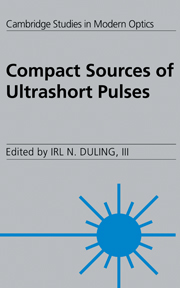Book contents
- Frontmatter
- Contents
- List of contributors
- Acronyms and abbreviations
- Preface
- 1 Short pulse generation
- 2 Passive modelocking in solid state lasers
- 3 Compact modelocked solid state lasers pumped by laser diodes
- 4 Modelocking of all-fiber lasers
- 5 Nonlinear polarization evolution in passively modelocked fiber lasers
- 6 Ultrafast vertical cavity semiconductor lasers
- 7 High power ultrafast semiconductor injection diode lasers
- 8 The hybrid soliton pulse source
- 9 Monolithic colliding pulse modelocked diode lasers
- Index
6 - Ultrafast vertical cavity semiconductor lasers
Published online by Cambridge University Press: 20 January 2010
- Frontmatter
- Contents
- List of contributors
- Acronyms and abbreviations
- Preface
- 1 Short pulse generation
- 2 Passive modelocking in solid state lasers
- 3 Compact modelocked solid state lasers pumped by laser diodes
- 4 Modelocking of all-fiber lasers
- 5 Nonlinear polarization evolution in passively modelocked fiber lasers
- 6 Ultrafast vertical cavity semiconductor lasers
- 7 High power ultrafast semiconductor injection diode lasers
- 8 The hybrid soliton pulse source
- 9 Monolithic colliding pulse modelocked diode lasers
- Index
Summary
Introduction
Modelocking was at first demonstrated in the mid-1960s using He-Ne lasers [1], ruby lasers [2], and Nd+ glass lasers [3]. The pulse width was initially quite long, but by the end of the 1970s subpicosecond pulses were generated using passive modelocked dye lasers [4–6]. The colliding pulse modelocking (CPM) of dye lasers in early 1980s [7] made sub-100 femtosecond pulses routinely available, and additive pulse modelocking (APM) of color center lasers pushed the wavelength of the sub-100 femtosecond pulses from the visible to the infrared [8, 9]. Kerr lens modelocking of Ti: sapphire lasers was discovered in 1990 [10–11] and produced the shortest laser pulses [12] directly from the laser cavity without any additional external cavity pulse compression. The advancement of short pulse generation technologies has provided very useful tools for researchers in physics, chemistry, biology, and optical communications. All of those ultrashort laser pulse systems are, however, large and expensive. A compact pulse source such as a modelocked semiconductor laser or fiber laser with comparable specifications to those big laser systems will be attractive because of its simplicity and cost effectiveness. Fiber lasers have limited cavity frequencies, typically below 100 MHz, and this limits their usefulness for many applications such as high bit-rate soliton transmission systems. Our goal with semiconductor modelocked lasers is to integrate the many fiber components into a compact, monolithic source.
Modelocked in-plane semiconductor lasers
Semiconductor lasers were demonstrated in 1962 by four groups almost simultaneously [13–16] only two years after the demonstration of the first laser [17].
- Type
- Chapter
- Information
- Compact Sources of Ultrashort Pulses , pp. 208 - 273Publisher: Cambridge University PressPrint publication year: 1995
- 4
- Cited by



